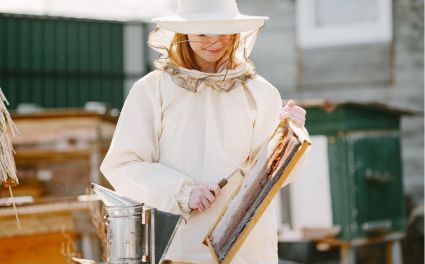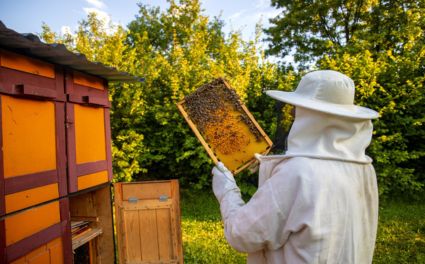Winterizing a beehive is important to protect bee colonies during cold winter weather. This process includes strategically keeping the hive warm, dry, and well-fed during the cold months. To keep a hive healthy, it's important to focus on three main things: insulation, food storage, and pest management. Beekeepers need to understand these basic steps to help their bee colonies survive and thrive in the winter season.
Assessment and Preparation
The first step in preparing a beehive for winter is to assess and prepare it thoroughly. Beekeepers should carefully assess the health and strength of their colonies. This involves checking for diseases, pests, and any signs of weakness.
Regular hive inspections help to identify and prevent potential problems early on. Additionally, it is important to keep the hive clean and debris-free to provide a sanitary environment for the bees. This practice helps stop disease spreading and keeps the living environment clean and comfortable.
Additionally, it is crucial for the colony's survival and productivity during the winter to have a strong population of bees and a healthy queen. It is important to check if there is enough food, like honey and pollen, for the bees during the colder months when they can't find as much food. Proper assessment and preparation are important for successfully winterizing a bee colony and ensuring its well-being.
Insulation and Ventilation
Keeping the beehive properly insulated and ventilated during the winter is important to maintain the best bee conditions. Beekeepers must ensure the hive is properly insulated to keep the bees warm. You can achieve this using straw, foam, or specialized hive wraps. Installing a moisture board is important because it helps absorb excess moisture and prevents harmful condensation, which can harm the hive's health.
Proper ventilation is important for regulating airflow in the hive and preventing stale air and moisture accumulation. Proper ventilation is important for keeping the bee environment dry and comfortable. This helps reduce the chances of diseases and mold growth. It is important to balance insulation and ventilation to create a suitable winter habitat for a bee colony.
Also read: How do bees reproduce?
Feeding
Feeding is important for preparing beehives for winter by providing enough food for the colonies during the cold season. Beekeepers need to be prepared to give extra food to their bees if the hive doesn't have enough natural food to support them. Sugar syrup or fondant can be used as effective supplements to provide the carbohydrates needed for energy and warmth.
Regularly monitoring food stores during the winter is crucial to prevent bees from starving. Evaluating the amount of food on hand and restocking if needed is important. Beekeepers can keep their bee colonies healthy during winter by carefully managing the amount of natural honey and supplemental feeding. This helps ensure the bees have enough food and remain strong, which is important for their survival and productivity.
Pest and Disease Management
It is important to effectively manage pests and diseases when preparing a beehive for winter. This helps protect the health and strength of the colony. Treating beehives for common pests like mites before winter is important to avoid infestations that may harm the bee population. It is important to regularly check for signs of diseases or infections, like foulbrood or chalkbrood, to identify and address any potential problems quickly.
Beekeepers must be watchful for signs such as unusual brood patterns or abnormal behavior in the bees. If any problems occur, it is important to address them promptly by using treatments like organic acids or natural remedies. This will help prevent the diseases from spreading and keep the colony healthy. Beekeepers can improve the health and strength of their bee population by using proactive strategies to manage pests and diseases.
Exterior Protection
Protecting the exterior of the beehive is crucial for maintaining a stable and secure environment for the colony during the winter season. A windbreak around the hive helps protect it from cold winds that can lower the temperature inside.
This helps reduce stress on the bees and keeps their internal climate stable. Additionally, it is important to elevate the hive using hive stands or suitable platforms. This helps prevent moisture buildup by allowing sufficient airflow beneath the hive. Reducing the risk of dampness, mold, and potential damage to the hive structure is important.
Entrance reducers are an important tool for protecting the exterior of a beehive. Reducers are used in hives to control the airflow and temperature. They help to reduce heat loss and prevent cold drafts from entering. In addition, beehives also discourage rodents and pests from entering and causing problems by seeking shelter or food. Beekeepers can improve the chances of their bee colony's survival and well-being during winter by using these exterior protection measures.
Also read: Bee Pollen Harvest
Monitoring
Vigilant monitoring of the beehive is essential during the winter months to ensure the well-being and survival of the bee colony. It is important to regularly check the hive for signs of activity and life in order to evaluate the bees' overall health. Beekeepers should regularly check the entrance of their beehives to see if bees are present. They should also watch for unusual behavior and inspect the combs for signs of disease or distress.
It is important to monitor the temperature and humidity levels in the hive. It is important to keep the temperature within a suitable range for bees to survive. Extreme cold or hot temperatures can harm them. Beekeepers can use thermometers or temperature probes to check the internal temperature regularly. It is important to manage humidity levels because too much moisture can cause mold and harm the bees' health. Using materials that absorb moisture or installing ventilation systems can effectively control humidity.
It is important to address any issues during monitoring to avoid potential losses quickly. Identifying signs of disease, addressing food shortages, and rectifying hive damage are all important for maintaining the stability and well-being of a colony. Immediate intervention is crucial in these situations. Beekeepers can keep their bee colonies healthy during the winter by regularly checking for problems and taking quick action to address them.
Emergency Preparedness
Being prepared for emergencies is crucial in ensuring the safety and survival of the bee colony during the winter season. It is important to have emergency food supplies, like extra sugar syrup or fondant, in case of long-lasting extreme weather or unexpected food shortages. The reserves can support the bees when there is a food shortage, preventing them from starving and keeping the colony healthy.
It is important to have a well-planned emergency intervention strategy in case the colony is in danger. The plan should include protocols for addressing issues like sudden declines in population, outbreaks of diseases, or damage to the hive structure. Taking quick and decisive action can reduce the impact of emergencies and increase the likelihood of the colony's survival.
It is important to be prepared with heat sources in regions with very cold temperatures. Using heat sources such as hive heaters or insulation materials can help keep the internal temperature of the hive at a safe level. This protects the bees from the negative effects of cold weather. Beekeepers can protect their colonies and better handle winter challenges by focusing on emergency preparedness.
Also read: How do bee colonies work?
Education and Consultation
Continual education and seeking consultation are pivotal for improving winterization practices and enhancing the overall management of beehives during the colder months. It is important to learn about winterizing techniques that are specific to your local climate and environmental conditions. Beekeepers can better care for their colonies by recognizing and addressing the specific challenges of the local winter conditions.
Seeking advice from experienced local beekeepers or experts in the field can offer valuable insights and guidance. Beekeepers can use their knowledge and experience to find practical solutions for common issues and make informed decisions about hive management and winterization techniques.
Beekeepers can enhance their knowledge and understanding by participating in workshops or seminars on winter hive management. These events are a great opportunity to learn about the latest advancements, best practices, and innovative solutions in beekeeping. They also provide chances for beekeepers to network and share experiences, creating a supportive community and allowing for the exchange of valuable information.
Record-keeping
Keeping thorough records is important for successful beekeeping, especially when preparing for winter. Beekeepers should carefully record hive inspections and activities, such as noting bee behavior, brood health, and honey stores. Keeping detailed records allows beekeepers to monitor the progress of their colonies and identify any patterns or issues that may need to be addressed.
It is important to keep a record of interventions and their outcomes. It would be best if you recorded any treatments given, changes made to the hive's environment, or adjustments made to feeding strategies. Recording the outcomes of these interventions offers useful information about how well they work and helps improve winterization methods for future purposes.
Using these records for future reference and improvement is important to develop an effective long-term winterization strategy. Analyzing previous data can help beekeepers identify successful practices and areas for improvement. This allows them to adjust their approach and improve the colony's resilience during future winters.
Beekeepers can better care for their colonies during winter by keeping detailed records. This helps them understand their bees' needs, make informed choices, and take proactive steps to ensure their well-being and survival.
Post-Winter Assessment
It is important to conduct a comprehensive assessment after winter to evaluate the effectiveness of winterization strategies and ensure the well-being of the bee colony. To assess the hive's health after winter, it is important to carefully examine the population size, brood patterns, and honey stores. Monitoring the health of bees and looking for signs of diseases or stress is important for understanding how well the colony will cope with the winter weather and survive.
To assess the effectiveness of winterization techniques, we need to compare the documented strategies with the actual outcomes observed in the hive. To determine the effectiveness of the measures taken, it is important to analyze factors such as the temperature inside the hive, how much food the bees consume, and how well pests are being managed.
Beekeepers should adjust and improve their winterization approach based on the post-winter assessment. This could include changing how insulation is done, when and how animals are fed, or using different methods to control pests. Beekeepers can improve their practices and help the bee population by learning from the strengths and weaknesses they observe during winter. This allows them to prepare their colonies for future winters better, promoting the bees' sustained health and productivity.
Also read: How does bee pollination work?
Final Thoughts
In conclusion, the careful winterization of beehives is crucial for supporting the vitality and longevity of bee colonies, especially during the challenging winter months. Beekeepers can support the well-being of their colonies during cold weather by using insulation, ensuring proper ventilation, and implementing strategic feeding.
It is important to regularly monitor for pests, diseases, and food storage to address any problems that may occur quickly. In addition, keeping thorough records and staying updated through ongoing education and discussions with other beekeepers and experts can greatly enhance winter preparation methods. Beekeepers can help protect their bee colonies and support the sustainability of bee populations and our ecosystem by being proactive and prepared for emergencies.



